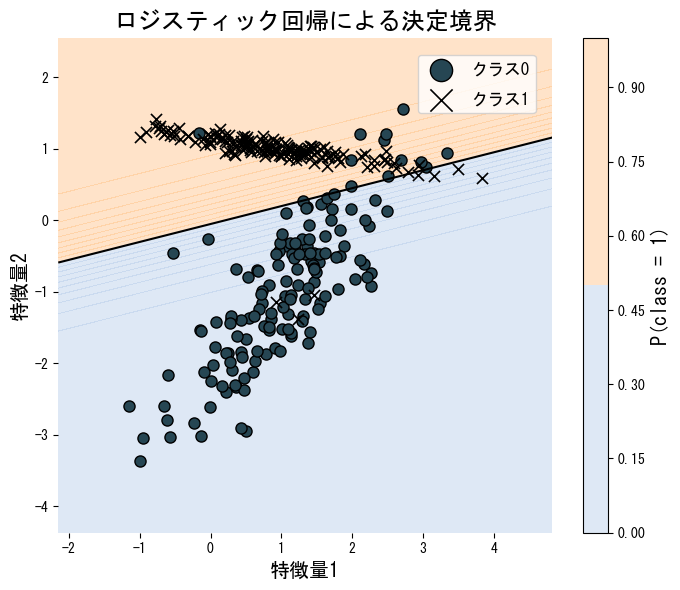まとめ
- ロジスティック回帰は入力の線形結合をシグモイド関数に通し、クラス1に属する確率を直接推定する二値分類モデルです。
- 出力が \([0, 1]\) に収まるため、意思決定のしきい値を柔軟に調整でき、係数は対数オッズ比として解釈できます。
- 学習はクロスエントロピー損失(対数尤度の最大化)で行い、L1/L2 正則化を組み合わせると過学習を抑えられます。
- scikit-learn の
LogisticRegressionを使えば、前処理から決定境界の可視化まで数行で実装できます。
直感 #
線形回帰の出力は実数全域に広がりますが、分類では「クラス1である確率」が欲しい場面が多くあります。ロジスティック回帰は線形結合 \(z = \mathbf{w}^\top \mathbf{x} + b\) をシグモイド関数 \(\sigma(z) = 1 / (1 + e^{-z})\) に通し、確率として解釈できる値を得ます。得られた確率に対して「0.5 を超えたらクラス1と予測する」といった単純なしきい値規則を決めるだけで分類できます。
数式で見る #
入力 \(\mathbf{x}\) に対するクラス1の確率は
$$ P(y=1 \mid \mathbf{x}) = \sigma(\mathbf{w}^\top \mathbf{x} + b) = \frac{1}{1 + \exp\left(-(\mathbf{w}^\top \mathbf{x} + b)\right)}. $$
学習は対数尤度
$$ \ell(\mathbf{w}, b) = \sum_{i=1}^{n} \Bigl[ y_i \log p_i + (1 - y_i) \log (1 - p_i) \Bigr], \quad p_i = \sigma(\mathbf{w}^\top \mathbf{x}_i + b), $$
の最大化(すなわち負のクロスエントロピー損失の最小化)として表現できます。L2 正則化を加えると係数の暴走を抑え、L1 正則化を組み合わせると不要な特徴量の重みを 0 にできます。
Pythonによる実験 #
次のコードは人工的に生成した2次元データにロジスティック回帰を適用し、決定境界を可視化した例です。LogisticRegression を利用するだけで学習から予測・境界の描画まで完結します。
from __future__ import annotations
import japanize_matplotlib
import matplotlib.pyplot as plt
import numpy as np
from matplotlib.colors import ListedColormap
from sklearn.datasets import make_classification
from sklearn.linear_model import LogisticRegression
from sklearn.metrics import accuracy_score
def run_logistic_regression_demo(
n_samples: int = 300,
random_state: int = 2,
label_class0: str = "クラス0",
label_class1: str = "クラス1",
label_boundary: str = "決定境界",
title: str = "ロジスティック回帰による決定境界",
) -> dict[str, float]:
"""Train logistic regression on a synthetic 2D dataset and visualise the boundary.
Args:
n_samples: Number of samples to generate.
random_state: Seed for reproducible sampling.
label_class0: Legend label for class 0.
label_class1: Legend label for class 1.
label_boundary: Legend label for the separating line.
title: Title for the plot.
Returns:
Dictionary containing training accuracy and coefficients.
"""
japanize_matplotlib.japanize()
X, y = make_classification(
n_samples=n_samples,
n_features=2,
n_redundant=0,
n_informative=2,
random_state=random_state,
n_clusters_per_class=1,
)
clf = LogisticRegression()
clf.fit(X, y)
accuracy = float(accuracy_score(y, clf.predict(X)))
coef = clf.coef_[0]
intercept = float(clf.intercept_[0])
x1, x2 = X[:, 0], X[:, 1]
grid_x1, grid_x2 = np.meshgrid(
np.linspace(x1.min() - 1.0, x1.max() + 1.0, 200),
np.linspace(x2.min() - 1.0, x2.max() + 1.0, 200),
)
grid = np.c_[grid_x1.ravel(), grid_x2.ravel()]
probs = clf.predict_proba(grid)[:, 1].reshape(grid_x1.shape)
cmap = ListedColormap(["#aec7e8", "#ffbb78"])
fig, ax = plt.subplots(figsize=(7, 6))
contour = ax.contourf(grid_x1, grid_x2, probs, levels=20, cmap=cmap, alpha=0.4)
ax.contour(grid_x1, grid_x2, probs, levels=[0.5], colors="k", linewidths=1.5)
ax.scatter(x1[y == 0], x2[y == 0], marker="o", edgecolor="k", label=label_class0)
ax.scatter(x1[y == 1], x2[y == 1], marker="x", color="k", label=label_class1)
ax.set_xlabel("特徴量1")
ax.set_ylabel("特徴量2")
ax.set_title(title)
ax.legend(loc="best")
fig.colorbar(contour, ax=ax, label="P(class = 1)")
fig.tight_layout()
plt.show()
return {
"accuracy": accuracy,
"coef_0": float(coef[0]),
"coef_1": float(coef[1]),
"intercept": intercept,
}
metrics = run_logistic_regression_demo(
label_class0="クラス0",
label_class1="クラス1",
label_boundary="決定境界",
title="ロジスティック回帰による決定境界",
)
print(f"訓練精度: {metrics['accuracy']:.3f}")
print(f"特徴量1の係数: {metrics['coef_0']:.3f}")
print(f"特徴量2の係数: {metrics['coef_1']:.3f}")
print(f"切片: {metrics['intercept']:.3f}")

参考文献 #
- Agresti, A. (2015). Foundations of Linear and Generalized Linear Models. Wiley.
- Hastie, T., Tibshirani, R., & Friedman, J. (2009). The Elements of Statistical Learning. Springer.